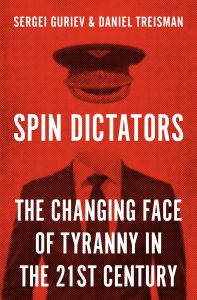In Spin Dictators: The Changing Face of Tyranny in the 21st Century, Sergei Guriev and Daniel Treisman argue that today’s authoritarian rulers have shifted from hard-line repression to subtler tactics. The book’s key concepts will find a home in future scholarship on authoritarianism and will inspire scholars to delve more into the changing character of today’s strongmen, writes Ilker Kalin.
Spin Dictators: The Changing Face of Tyranny in the 21st Century. Sergei Guriev and Daniel Treisman. Princeton University Press. 2022.
 Find this book (affiliate link):
Find this book (affiliate link):![]()
In Spin Dictators, Sergei Guriev and Daniel Treisman offer a comprehensive and timely account of not only how the new strongmen of the world accumulate power while presenting a façade of democracy, freedom and modernity, but also why we witness a shift in the dictator’s playbook from hard-line repression tactics to subtler ones. The authors coin the term ‘spin dictators’ to make their point and to distinguish today’s authoritarian rulers from those of the twentieth century. The main difference appears to be that while most twentieth-century dictators, such as Stalin, Hitler and Mao, ruled by intimidation, today’s strongmen, such as Victor Orbán in Hungary, Lee Hsien Loong in Singapore and Erdoğan in Turkey, rule by popularity.
Guriev and Treisman divide dictators into two categories: fear and spin. The former attempts to maintain power by violently repressing and punishing opposition, controlling all communication tools, denouncing the notion of pluralist democracy and blocking cross-border flows of information and people (10). The latter manipulates information to shape public opinion and to create popular support, all while pretending to be democrats, evading violent and direct repression and opening up their countries to the outside world (18). Thus, spin dictators are more focused on shaping public opinion than directly repressing people, which appears to be a more efficient and less costly alternative.

Image Credit: Image by Tung Thanh from Pixabay
The authors emphatically note that the division between fear and spin dictators is not absolute. Firstly, not all authoritarians of today are spin dictators, given that the regimes in Saudi Arabia, China and Iran still rule by fear and rely heavily on overtly violent tactics to control society and maintain power. Yet, what Guriev and Treisman try to drive home is the idea that today more rulers rely on subtler forms of control and manipulation than the old violent and overtly repressive tactics. This is supported by the empirical evidence provided in the book that the share of spins among dictators soared from 13 to 53 per cent from the 1970s to the 2000s (22).
Secondly, dictators can switch tactics during the course of their stay in power. For example, when Vladimir Putin first came to power in 2000 in Russia, he claimed to accept the principles of democracy. For a time, he preserved democratic appearances while slowly undermining checks and balances and concentrating power in his hands. The booming economy was also on his side to boost his popularity and hide undemocratic practices. By the time Putin returned to the Russian Presidency in 2012, he was clearly following a different playbook that was closer to that of fear dictators, which could be due to the fear of losing power triggered by the 2011 mass demonstrations that swept across Russia over alleged fraud in the parliamentary elections of that year (5).
Moreover, the authors note that a neat categorisation of dictators as either fear or spin would run the risk of losing sight of the real world as most things vary along a spectrum. Just as ‘perfect democracy’ only exists in textbooks and regimes are often more or less democratic, authoritarian regimes ‘may be closer to the dictatorship of fear or the dictatorship of spin, but few will be entirely one or the other’ (19).
Spin Dictators is divided into two sections. The first, entitled ‘how it’s done’, consists of five chapters that break down new authoritarian strategies and tactics to control society and maintain political power. While there is admittedly a rich repertoire of new authoritarian tactics, the authors draw our attention to certain features that these have in common: they are indirect rather than direct; (often) nonviolent rather than violent; and covert rather than overt. Unlike fear dictators, spin dictators do not punish their opponents directly or violently. Instead, they try to discipline them by charging them with non-political but disreputable crimes, which vary depending on the creativity of the regime: for example, Kazakhstan’s President Nazarbayev used accusations of money laundering, corruption and weapon possessions to prosecute political rivals and journalists (51).
According to Guriev and Treisman, ‘postmodern propaganda’ is another important tool in the hands of spin dictators. While old-school dictators would use propaganda to spread fear and improve the effectiveness of repression, spin dictators use propaganda to show their competence and leadership skills. Almost all strongmen of the 21st century, such as Kazakhstan’s Nazarbayev, Venezuela’s Hugo Chávez and Turkey’s Erdoğan, have liked to appear on TV and boast about the peace and prosperity they have brought to the country. When things are going well, they take credit. When not, they have the co-opted media to tell a distorted story of the facts.
Accordingly, spin dictators invest significantly in controlling the media, but not in an old-fashioned way aiming at full-scale censorship. Instead, they co-opt media bosses and journalists who can be bought off and wear down others with lawsuits, arbitrary regulations and/or pseudo-technical problems, all while still allowing them to operate. While a token of opposition media serves as proof that the regime is respecting press freedom, spin dictators build devoted pro-regime media that shapes information and thereby public opinion in favour of the dictator.
The second section of the book, entitled ‘modernisation cocktail’, elaborates on why the shift from ‘fear’ to ‘spin’ has happened in the 21st century and what the future holds for spin dictators. The authors deem a ‘modernisation cocktail’ as ‘interconnected forces related to economic and social modernization combined with globalization’ (170). Adapting the prominent ‘modernisation theory’, the authors contend that in post-industrial societies with the globalisation of economies and information, people not only start to demand more individualistic lifestyles and freedom, but also have better organisational skills and capacity to resist. Besides, the growing appeal of the international liberal order increases pressure on authoritarian regimes to respect human rights and freedom. All these raise the cost of violent repression and force authoritarian leaders to adapt a new playbook.
The authors, however, conclude with optimism by stating that spin dictators only prolong the lifespan of authoritarian regimes, but are eventually bound to lose as they offer no vision or ideology for emerging societies and world issues. On the contrary, the authors claim, the West has something to offer: the idea of liberal democracy (219). Yet, for it to work, the authors suggest that the West should (first) fix its own problems, stop fuelling authoritarian regimes, improve international institutions and promote democracy democratically.
Overall, Guriev and Treisman offer an insightful analysis of the changing face of dictators and why this shift is happening now. The book brilliantly compares the practices of fear and spin dictators, referring to many historical and contemporary cases from around the world. While the book is built on extensive research and data, it is written in a tone that is at times sarcastic, easy to follow and accessible not only to academics but also anyone interested in the topic. For those looking to explore the research and data behind the theoretical arguments, the authors spare a section at the end of each chapter to ‘checking the evidence’, presenting data and referring readers to additional resources and evidence published elsewhere.
The term ‘spin dictator’ is likely to find a home in future scholarly work on authoritarianism and will inspire scholars to delve more into the changing character of authoritarians. Insights provided by the book could also be integrated into diverse fields, including civil resistance studies, social movements and international relations.
- This review first appeared at LSE Review of Books.
- Please read our comments policy before commenting.
- Note: This article gives the views of the author, and not the position of USAPP – American Politics and Policy, nor of the London School of Economics.
- Shortened URL for this post: https://bit.ly/3QVpo9h






